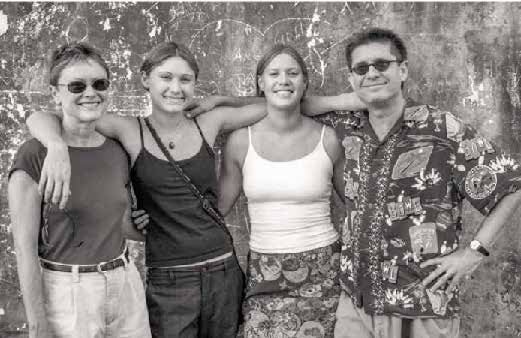(THIS ARTICLE IS MACHINE TRANSLATED by Google from Norwegian)
Where the Time Goes would not have been created unless David Pace had contracted a rare form of lymphoma, says initiator and spouse Diane Jonte-Pace towards the end of this photo book. It does not catch me immediately, but is read differently in light of the waiting time before the announced death. Snapshots from half a century of cohabitation, marriage, joint children and travels from countless latitudes give room for reflection that one can never be so resourceful, but still weakly equipped to say goodbye.

In meeting with the photo book, it is not the quality of the pictures, but the project's function that fascinates. For the Pace couple, the photographs become a portal to another time, and collection and sorting is a possible coping strategy as they both need a joint project to gather around in the face of the inevitable cancer. Diane elaborates that the photographs make people aware of what is about to be lost. Her formulations can also be interpreted as an insistence that reunion activates memories that can be reclaimed.
As the disease took hold, David Pace's photographs sparked great support from colleagues and friends. In recent years, Pace has worked as an anthropological photographer in Africa, and empathy therefore also came from far and wide. In both cases, the patient was aware that the document was to be shared. Social media and our relationship with the sender strengthened the importance of the published images. But do private snapshots have the power to make this interesting beyond your own circle?

Photo album?
 Is this photo book really an edited photo album for those closest to you and not a monument to lived life that differs from the ordinary and established? The text refers to a rebellious and rough life, trips in Death Valley and more. Such a visual communication – if it had been included, would have had a contrasting effect on what is otherwise the account of a streamlined established existence. Not because this existence is actually like that, but because this is what is conveyed via the photo selection. The more genuine that exists in any lived life has possibly been edited away or never been captured by camera.
Is this photo book really an edited photo album for those closest to you and not a monument to lived life that differs from the ordinary and established? The text refers to a rebellious and rough life, trips in Death Valley and more. Such a visual communication – if it had been included, would have had a contrasting effect on what is otherwise the account of a streamlined established existence. Not because this existence is actually like that, but because this is what is conveyed via the photo selection. The more genuine that exists in any lived life has possibly been edited away or never been captured by camera.
With memories from many places immortalized over five decades have Where the Time Goes a rich starting point. Photo from the beginning of the relationship to what could have been the end, forms the frame interspersed with some texts. The pictures bear the mark of another time's patina. Nevertheless, most of them are lined up and stiff, despite the fact that they have a different calm than the same type of pictures from today. The erected photograph from fifty years ago does not have the same eager insistence on being flashy as today. But there is something missing, a spark, a feeling, a sensitivity to situation, relationship. Even from Pace's active photo career in Africa, the images are subdued and straightforward. These too are characterized by a more anthropological approach to photography. The documentation takes precedence over the aestheticizing or authentic. The individual centrally located has been photographed for five decades without me as a spectator being further affected.

Famous genre
Photography or film as a method of being able to say goodbye is an increasingly well-known method and genre. Lastly is the Norwegian documentary and Amanda winner Self-Portrait, where the main character documents his own anorexia. In this film, Lene Marie Fossen cancels her own deadly diagnosis with the help of exceptionally strong artistic power, as a photographer. Her photography bursts through all prejudices and perceptions and moves me as if at an unexpected encounter. In the meeting with the photo book of the Pace family, little happens to me as a reader. Yes, time passes. Life offers pain, but it grips me to a small degree.

Photography is ubiquitous and permeates our modern contemporary culture. It has the ability to capture the moment and immortalize it. Here in Where Time Goes, it is not the moment that is immortalized, but something one has perceived could illustrate it. In a culture oversaturated with photographs, it takes a lot to grab the viewer.
At the same time, in our digital age, physical photo albums are disappearing. Memories from decades are deleted. Perhaps this book is important precisely to remind all of us to recapture these using the tactile and close feeling it gives to browse a great album.
All photos from the book


